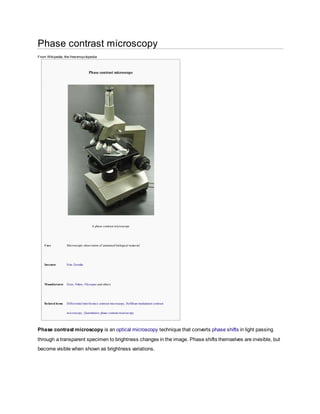Phase contrast microscopy allows biologists to study living cells by making subtle phase shifts in light passing through a specimen visible as brightness variations in the image. It reveals many cellular structures not visible with bright field microscopy and does not require staining cells. Frits Zernike invented phase contrast microscopy in the early 1930s and was awarded the Nobel Prize in Physics in 1953 for this important advancement in microscopy. Phase contrast works by separating illuminating background light from scattered specimen light and manipulating them differently to increase contrast between foreground and background details in the image.

![Figure 1: The same cells imaged with traditional bright field microscopy (left) and with phase contrast microscopy (right).
When light waves travels through a medium other than vacuum, interaction with the medium causes the
wave amplitude and phase to change in a manner dependent on properties of the medium. Changes in
amplitude (brightness) arise from the scattering and absorption of light, which is often wavelength dependent
and may give rise to colors. Photographic equipment and the human eye are only sensitive to amplitude
variations. Without special arrangements, phase changes are therefore invisible. Yet, phase changes often
carry important information.
Phase contrast microscopy is particularly important in biology. It reveals many cellular structures that are not
visible with a simpler bright field microscope, as exemplified in Figure 1. These structures were made visible to
earlier microscopists by staining, but this required additional preparation and killed the cells. The phase
contrast microscope made it possible for biologists to study living cells and how they proliferate through cell
division.[1]
After its invention in the early 1930s,[2]
phase contrast microscopy proved to be such an
advancement in microscopy, that its inventor Frits Zernike was awarded the Nobel prize (physics) in 1953.[3]](https://image.slidesharecdn.com/phasecontrastmicroscopy-150428014112-conversion-gate01/85/Phase-contrast-microscopy-2-320.jpg)
![The basic principle to make phase changes v isible in phase contrast microscopy is to separate the illuminating background light f rom the specimen
scattered light, which make up the f oreground details, and to manipulate these dif f erently.
The ring shaped illuminating light (green) that passes thecondenser annulus is f ocused on the specimen by the condenser. Some of the illuminating
light is scattered by the specimen (y ellow). The remaining light is unaf f ected by the specimen and f orms the background light (red). When observ ing
unstained biological specimen, the scattered light is weak and ty pically phase shif ted by -90° — relativ e to the background light. This leads to that the
f oreground (blue v ector) and the background (red v ector) nearly hav e the same intensity , resulting in a low image contrast(a).
In a phase contrast microscope, the image contrast is improv ed in two steps. The background light is phase shif ted -90° by passing it through a phase
shif t ring. This eliminates the phase dif f erence between the background and the scattered light, leading to an increased intensity dif ference between
f oreground and background (b). To f urther increase contrast, the background is dimmed by a gray f ilter ring (c). Some of the scattered light will be
phase shif ted and dimmed by the rings. Howev er, the background light is af f ected to a much greater extent, which creates the phase contrast ef f ect.
The abov e describes negative phase contrast. In its positive f orm, the background light is instead phase shif ted by +90°. The background light will thus
be 180° out of phase relativ e to the scattered light. This results in that the scattered light will be subtracted f rom the background light in (b) to f orm an
image where the f oreground is darker than the background, as shown in Figure 1.[4][5][6][7][8][9]
Phase shift is any change that occurs in the phase of one quantity , or in the phase dif f erence between two or more quantities.[1]
is sometimes ref erred to as a phase shift or phase offset, because it represents a "shif t" f rom zero phase.
For inf initely long sinusoids, a change in is the same as a shif t in time, such as a time delay . If is delay ed (time-shif ted) by of its cycle, it becomes:
Phase difference is the dif f erence, expressed in electrical degrees or time, between two wav es hav ing the same f requency and ref erenced to the
same point in time.
[1]
Two oscillators that hav e the same f requency and no phase dif f erence are said to be in phase. Two oscillators that hav e the
same f requency and dif f erent phases hav e a phase dif f erence, and the oscillators are said to be out of phase with each other. The amount by which
such oscillators are out of phase with each other can be expressed in degrees f rom 0° to 360°, or in radians f rom 0 to 2π. If the phase dif f erence is 180
degrees (π radians), then the two oscillators are said to be in antiphase. If two interacting wav es meet at a point where they are in antiphase, then
destructiv e interf erence will occur. It is common f or wav es of electromagnetic (light, RF), acoustic (sound) or other energy to become superposed in
their transmission medium. When that happens, the phase dif f erence determines whether they reinf orce or weaken each other. Complete cancellation
is possible f or wav es with equal amplitudes.](https://image.slidesharecdn.com/phasecontrastmicroscopy-150428014112-conversion-gate01/85/Phase-contrast-microscopy-3-320.jpg)
